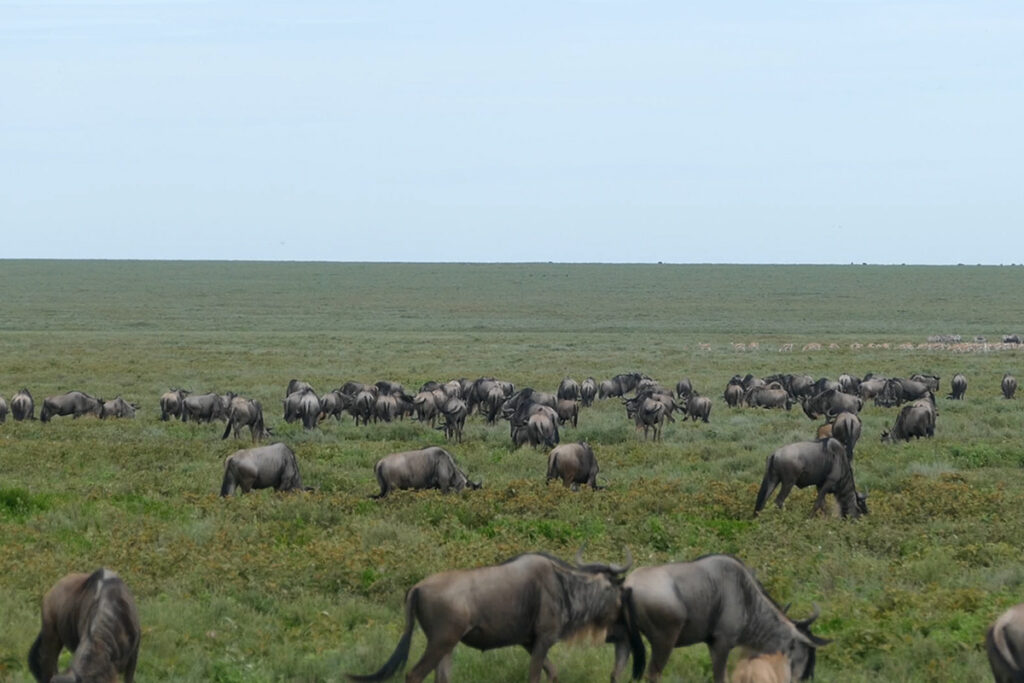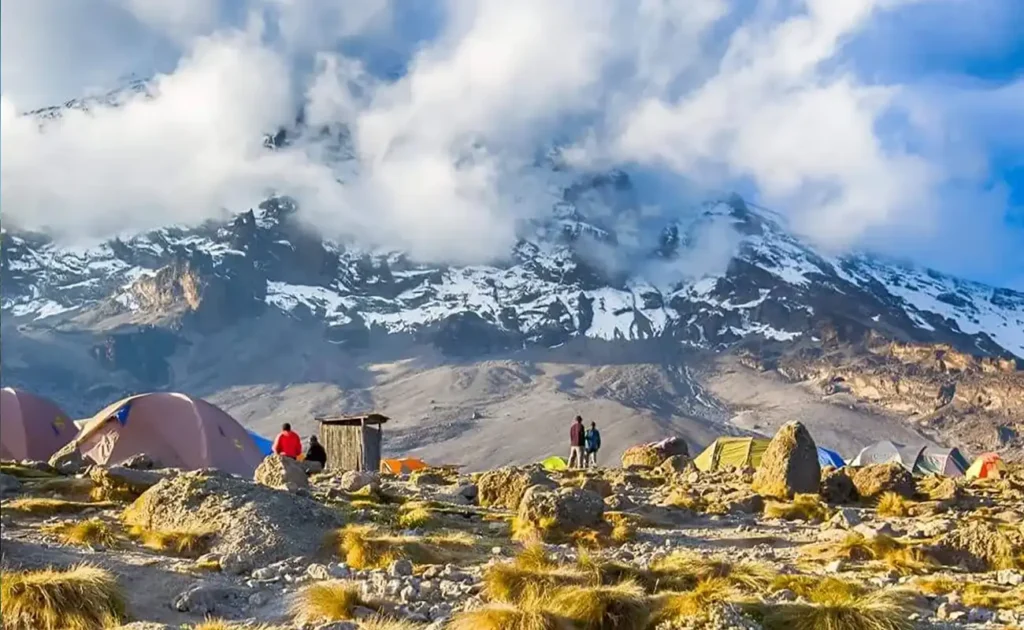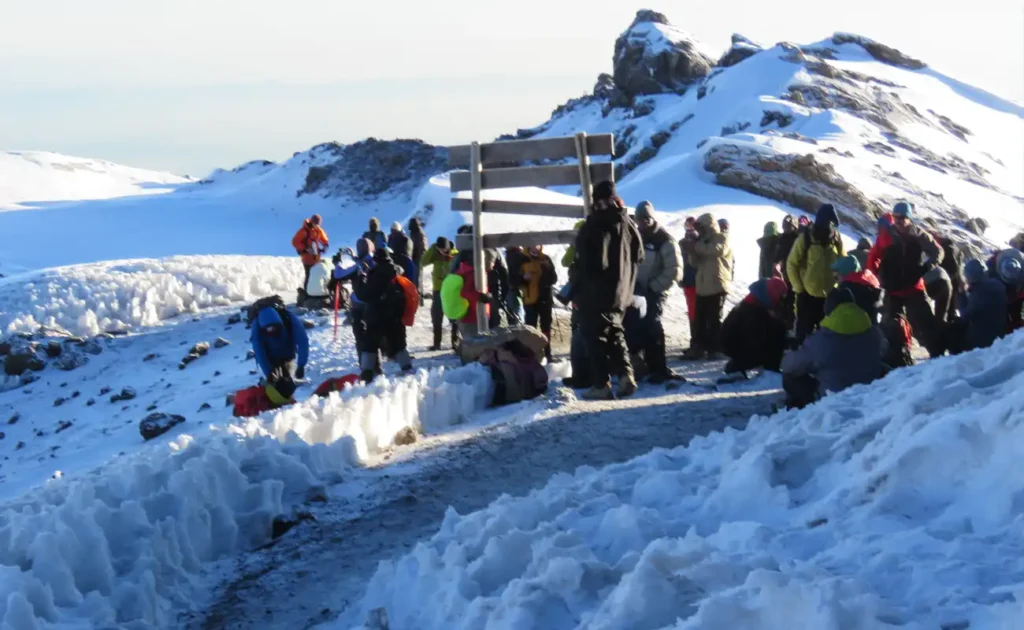Every year, millions of wildlife enthusiasts flock to the plains of East Africa, seeking the raw, unfiltered beauty of the region’s iconic landscapes. But the age-old question remains: which country offers the ultimate safari experience, Tanzania or Kenya? Some argue it’s the unique topography of Tanzania’s Serengeti, while others swear by the mesmerizing allure of Kenya’s Maasai Mara.
Both have their unique charm and historical significance. Kenya, home to the famous Maasai Mara, has been a staple of the safari industry since the early 20th century. Conversely, Tanzania’s Serengeti hosts the Great Migration, where over 1.5 million wildebeest traverse annually – a spectacle like no other. Choosing between the two often boils down to the particular wildlife experiences one desires.

Tanzania vs Kenya Safari: An Overview
Tanzanian safaris are famed for their diverse landscapes and abundant wildlife. The Serengeti National Park, a key highlight, is renowned for the Great Migration, where millions of wildebeest and zebras move across the plains. Meanwhile, Mount Kilimanjaro, Africa’s highest peak, provides a stunning backdrop for any safari adventure. In addition, Tanzania offers unique cultural experiences with visits to local Maasai villages, enriching the overall journey. Many travelers find the blend of natural beauty and cultural encounters truly captivating.
Kenya, on the other hand, boasts the iconic Maasai Mara National Reserve. This park is famous for its large population of lions, cheetahs, and leopards, among other wildlife. It’s also a prime location to witness part of the Great Migration, offering incredible photo opportunities. Visitors can enjoy hot air balloon safaris, which provide a breathtaking view of the savanna. According to this post, Kenya’s accessibility and well-developed tourist infrastructure make it a favorite for many first-time safari-goers.
Both countries offer a range of safari packages, catering to different budgets and preferences. You can choose from luxury lodges with all the amenities to more rustic, budget-friendly options that bring you closer to nature. Each experience ensures visitors can enjoy the stunning landscapes and rich wildlife. The choice between Tanzania and Kenya often comes down to personal preference and what specific experiences one seeks. Whether it’s the vast Serengeti or the vibrant Maasai Mara, both destinations promise unforgettable adventures.
Weather and terrain also play a crucial role in the safari experience. Tanzania’s varied climates range from tropical along the coast to more arid regions inland. This diversity supports an astounding variety of ecosystems and wildlife habitats. Kenya’s landscapes, characterized by savannas, mountains, and lakes, similarly support diverse fauna. These geographical differences highlight the unique aspects each country brings to a safari, ensuring there’s something for every traveler.
Unique Aspects of Tanzanian Safaris
Tanzanian safaris are celebrated for their breathtaking landscapes and fascinating wildlife. The Serengeti National Park, a UNESCO World Heritage site, is a popular destination for seeing the Great Migration. Here, travelers witness thousands of animals moving in search of greener pastures. This natural event is one of the world’s most impressive wildlife spectacles. The spectacle remains etched in the memories of all who experience it.
Besides the Serengeti, Tanzania’s Ngorongoro Crater offers a unique safari experience. This massive crater acts as a natural enclosure, providing a home for over 25,000 animals. Visitors can spot lions, elephants, and even the endangered black rhinoceros. The diverse habitats within the crater support a wide range of species. This biodiversity is unmatched in many other safari locations.
Climbing Mount Kilimanjaro, Africa’s highest peak, is another exciting adventure. The journey to the summit provides stunning views and showcases Tanzania’s diverse terrain. The mountain is surrounded by rich rainforests, home to many unique species. For those who prefer cultural experiences, visiting the Maasai villages offers fascinating insights into their age-old traditions and way of life. These cultural excursions create a deeper, richer travel experience beyond just wildlife observation.
Finally, Tanzania’s location along the Indian Ocean means travelers can combine a safari with relaxing beach visits. The tranquil beaches of Zanzibar offer the perfect spot to unwind after thrilling safari days. Visitors can enjoy sunbathing, snorkeling, or exploring the island’s history and spice plantations. This combination of adventure and relaxation appeals to many travelers. It’s a perfect way to experience Tanzania’s multifaceted charm.
Distinctive Features of Kenyan Safaris
The Maasai Mara National Reserve is the crown jewel of Kenyan safaris. Known for its resident big cats, it’s a haven for spotting lions, cheetahs, and leopards. Visitors often witness thrilling predator-prey interactions on the vast plains. Hot air balloon rides over the Maasai Mara provide stunning aerial views. This unique way to experience the landscape makes Kenya remarkable.
Kenya’s diverse terrain ranges from savannas to mountains, and lakes. One notable destination is Lake Nakuru, famous for its pink flamingo population. The lake attracts birdwatchers from around the globe. Nearby, you can find plenty of rhinos and other water-loving creatures. These varied environments create a rich safari experience for all visitors.
Another distinctive feature of Kenyan safaris is the well-established tourism infrastructure. Many luxurious lodges and tented camps provide comfortable accommodations in the heart of the wilderness. This combination of modern comfort and natural beauty is a major draw. Moreover, guided tours offer in-depth knowledge about the flora and fauna. This ensures visitors can fully appreciate the environment and its inhabitants.
Kenya also offers cultural immersion opportunities with the local Maasai communities. Visiting Maasai villages gives insight into their traditional lifestyle. Travelers can learn about their customs, dance, and vibrant clothing. These interactions add a valuable dimension to the safari experience. The blend of wildlife adventure and cultural exploration sets Kenyan safaris apart from others.
Wildlife Diversity in Tanzania and Kenya
Both Tanzania and Kenya are renowned for their incredible wildlife diversity. In Tanzania, the Serengeti National Park is a hotspot for spotting various species. You can find the “Big Five” animals: lions, leopards, rhinoceros, elephants, and buffaloes. The park is also home to millions of wildebeest and zebras, especially during the Great Migration. This diversity creates a vibrant ecosystem, attracting nature enthusiasts worldwide.
Kenya offers its own set of unique wildlife experiences. The Maasai Mara is well-known for its large populations of big cats and the annual migration of wildebeest. In addition to these, visitors can encounter hyenas, giraffes, and hippos. The Amboseli National Park is another gem, famous for its big elephant herds. These diverse ecosystems highlight the richness of Kenya’s natural habitats.
A closer look at birdlife reveals even more about these countries’ biodiversity. Tanzania’s Lake Manyara is a birdwatcher’s paradise, hosting flamingos and pelicans. Similarly, Kenya’s Lake Nakuru is famous for its flamingos and over 400 other bird species. With the wide range of avian life, both locations provide rewarding experiences for bird enthusiasts. Visitors are often amazed by the colorful displays of nature’s avians.
Special conservation areas in these countries help protect and study endangered species. The Serengeti and Maasai Mara are vital for wildlife research and offer protection against poachers. Both places work with local and international groups to conserve wildlife. Besides bolstering tourism, these initiatives are crucial for the survival of key species. Understanding their significance makes visits even more rewarding.
Engaging cultural elements enhance the wildlife experience. Tours often include visits to local communities, allowing travelers to learn about how these cultures coexist with wildlife. Maasai and other local groups play important roles in conservation through eco-tourism projects. This cooperation benefits both wildlife and local people. Such interactions provide added depth to safari adventures in Tanzania and Kenya.
The Great Migration: Tanzania’s Serengeti vs Kenya’s Maasai Mara
The Great Migration is an awe-inspiring natural event, attracting wildlife enthusiasts from around the globe. Each year, over 1.5 million wildebeest, along with hundreds of thousands of zebras and gazelles, trek across the Serengeti and Maasai Mara ecosystems. In Tanzania, the migration begins in the southern Serengeti during the calving season. This time of year, the lush grasslands provide ample food for newborn calves. The spectacle of predators following these herds adds to the thrilling drama.
As the seasons change, the herds move northward, eventually reaching Kenya’s Maasai Mara around July. Here, the herds face one of their toughest challenges: crossing the Mara River. This crossing is fraught with danger, as crocodiles lying in wait make the journey perilous. Witnessing this incredible event is a highlight for many safari-goers. The strong currents also challenge the animals, making survival even tougher.
The differences between the two parks, Serengeti and Maasai Mara, are noteworthy. The Serengeti spans Tanzania and provides expansive landscapes for the herds’ journey. Its diversity in flora and fauna creates varied habitats for diverse animal species. Conversely, the Maasai Mara is smaller yet teems with wildlife, thanks to its rich grasslands and water sources. This concentration of wildlife offers abundant opportunities for close encounters.
Choosing when to visit either location depends on personal preferences and the timing of the migration. For those wanting to see the birthing season, Tanzania’s Serengeti is ideal from January to March. Meanwhile, the dramatic river crossings are best viewed in Kenya’s Maasai Mara from July to September. The excitement of seeing such massive herds thunder across the plains captivates the hearts of many. Both places provide unique experiences that can’t be matched elsewhere.
Besides witnessing the migration, visitors often explore the regions’ surrounding attractions. The Maasai Mara offers cultural visits to Maasai villages, enriching the safari experience with local interactions. In Tanzania, extending the adventure to Ngorongoro Crater provides a different environment rich with wildlife. These additional experiences complete the safari and showcase the diverse beauty of East Africa. They make the journey to watch the Great Migration even more worthwhile.
Safari Accommodation: Comparing Luxury and Budget Options
When planning a safari, choosing the right accommodation is essential. Luxury lodges cater to travelers seeking comfort and exclusivity. These lodges offer amenities like spa services, gourmet meals, and private game drives. Staying in such places provides an elevated safari experience. The views from these lodges are often breathtaking, adding to the sense of adventure.
For those on a budget, Tanzania and Kenya offer affordable options without sacrificing the experience. Budget lodges and campsites bring guests close to nature, often situated near wildlife areas. These accommodations provide basics like clean beds and ready-to-eat meals. The focus is on the immersive experience of being in the wild. Campfires and guiding services make these stays memorable.
Comparing the two options highlights unique benefits and trade-offs. Luxury accommodations deliver comfort and personalized service. In contrast, budget accommodations allow for greater flexibility and connection to the environment. Solo travelers or those in groups often favor budget options for their affordability. Both choices allow guests to experience the stunning landscapes and diverse wildlife.
Some camps and lodges blend both luxury and affordability. Mid-range lodges offer comfortable yet relaxed settings. These lodges balance comfort with a sense of adventure. Here, visitors can enjoy cozy rooms and delicious meals without high costs. This mix appeals to many, providing a great alternative to pure luxury or basic stays.
Regardless of the choice, each type of accommodation provides unforgettable memories. Proximity to nature, whether through luxury suites or simple tented camps, enriches the safari adventure. Every safari-goer finds value in exploring wildlife-rich settings and experiencing the local culture. The wide range of options ensures a suitable choice for every type of traveler. The essential factor is selecting what aligns best with individual preferences and budgets.
Best Time for Safari: Seasonal Differences Between Tanzania and Kenya
The timing of a safari plays a crucial role in the overall experience. In Tanzania, the dry season from late June to October is often considered the best time for wildlife viewing. During these months, animals are more easily spotted as they gather around water sources. This period also coincides with the dramatic river crossings during the Great Migration. The scenery is simply magnificent.
On the other hand, Kenya’s prime safari season runs from July to October, similar to Tanzania. However, the Maasai Mara also sees abundant wildlife activity between January and March during its short dry season. These periods offer excellent game-viewing opportunities as animals concentrate in accessible areas. The weather remains pleasant, ensuring an enjoyable adventure for visitors.
Rainy seasons bring their own charm but might be less ideal for some travelers. In Tanzania, November and December witness short rains while March to May sees longer rainy periods. Conversely, Kenya experiences long rains from March to May and shorter rains around November. These seasonal showers transform landscapes into lush green havens full of life, albeit with increased mosquito activity.
An advantage of traveling during off-peak times includes fewer crowds and lower prices on accommodations and tours.
- Fewer tourists mean more intimate game viewing experiences
- Accommodation rates tend to drop significantly
- Parks are quieter with lesser vehicle traffic
This can enhance your connection with nature without compromising on sightings.
| Savanna Tip: |
|---|
| If you seek fewer crowds but want optimal wildlife encounters (minus river crossings), visit in February when newborn calves abound—a sight worth seeing! |
| Avoiding heavy rain impacts roads minimally but requires waterproof gear just-in-case downpour occurs spontaneously amidst changing tropical climate conditions prevalent both destinations; forecast unpredictably fluctuates frequently throughout year unlike temperate northern zones standard set-scheduled seasons historically regulated globally climatic phenomena’s patterns observation networks past decades research evidence documentations studies continuing projects worldwide collaborations scientists meteorologists institutes organizations governments increase accuracy predictions future generations abilities refine parameters detections intelligence capacities! 😊🌍💦📅 🔬📝🚙 🐾🌳🍢💚👶😊🔭✨️🚘🐾💚🍃🧳 ☔ 🧥 📆 🌿 🔄➖data collect compile analyze publish benchmarks comparisons gathered ongoing multiple angles perspectives objectives definite proof gradual timely manner feasible approach develop comprehensive understanding ecosystem challenges reality accept responsibility embrace involvement contribute movements solution levels need effort unity cooperation commitment towards achieving success maintaining balance harmony sustainability healthy planet generations cause action planning issues preserving life forms thrives beauty vitality resilience 🌱🐼 📈❤️👏🤝 🇺🇳
Frequently Asked QuestionsGoing on a safari in Tanzania or Kenya offers a chance to see amazing wildlife up close. Here are some common questions and detailed answers to help plan your safari adventure. 1. What is the best time to visit the Serengeti or Maasai Mara for the Great Migration?The best time to see the Great Migration typically falls between July and October. During these months, animals cross the Mara River, creating dramatic scenes. This period guarantees breathtaking wildlife interactions within both Tanzania’s Serengeti National Park and Kenya’s Maasai Mara Reserve. However, if you’re focused on the calving season, visit the Serengeti from January to March. At this time, wildebeest give birth to about 500,000 calves. This draws numerous predators, providing a unique opportunity to observe nature’s raw dynamics. 2. Are luxury or budget accommodations better for a safari experience?Both luxury and budget accommodations provide rewarding safari experiences, merely catering to different preferences. Luxury lodges offer high-end amenities like gourmet dining and guided game drives, perfect for a pampered experience. Conversely, budget-friendly camps provide an authentic, nature-centric experience. These camps ensure basic comforts while positioning guests closer to the wild. Ultimately, both options allow a deep connection with the landscape and wildlife. 3. What wildlife can I expect to see in these parks?Tanzania’s Serengeti and Kenya’s Maasai Mara offer diverse wildlife viewing opportunities. You can witness the iconic Big Five: lions, leopards, rhinoceros, elephants, and buffalo, roaming freely. Both locations also host stunning birdlife, making them ideal for birdwatchers. Visitors to these parks also enjoy sightings of zebras, cheetahs, and giraffes. During the Great Migration, herds of wildebeest and zebras trek across clear terrains. This vibrant display of life captivates anyone lucky enough to witness it. 4. How do conservation efforts affect safaris?Conservation efforts are vital in protecting wildlife and maintaining safari experiences. Initiatives ensure that these natural habitats remain sustainable for both the animals and visitors. Collaborations between governments, NGOs, and local communities play crucial roles. These efforts help regulate animal populations and prevent poaching. As a result, safari-goers enjoy durable tourism experiences, knowing their visits contribute to conservation. Responsible tourism bolsters conservation work, safeguarding these regions for future generations. 5. What cultural experiences can I have alongside a safari?Safaris offer opportunities to engage with local cultures and traditions, enriching your adventure. Visits to Maasai villages allow one to learn about their customs, dances, and colorful attire. Visitors can also experience traditional meals and participate in story-telling sessions. Similar experiences exist in Tanzania, with numerous tribal communities open to sharing their heritage. This cultural engagement provides a deeper understanding of the local way of life. It enhances the safari experience beyond simply observing wildlife. Best Tanzania Safari ToursWhether you’re traveling alone, with a partner, or in a group, we can customize the duration, accommodation, and activities to suit your preferences. From luxury lodges to budget camping, there’s an option for everyone. You can also add unique experiences like cultural visits or hot air balloon rides to make your safari unforgettable. 5 Days Serengeti Experience BudgetTour Type: Budget Safari, Joining Groups Places To Visit: Ngorongoro Crater, Serengeti NP, Lake Manyara NP, Tarangire NP 6 Days Machame Route Kilimanjaro ClimbingTour Type: Mountain Climbing Places To Visit: Kilimanjaro National Park 7 Days Lemosho Route Kilimanjaro ClimbingTour Type: Mountain Climbing Places To Visit: Kilimanjaro National Park Discover the unparalleled beauty of Tanzania with expertly crafted safari experiences designed just for you. From the majestic Serengeti to the towering peaks of Kilimanjaro, our tailored safaris offer a perfect blend of adventure, luxury, and cultural immersion. Whether you're a seasoned explorer or embarking on your first journey, Sia Yangu Safaris ensures an unforgettable adventure that meets your every need and desire. Begin your Tanzanian odyssey with us today! |




